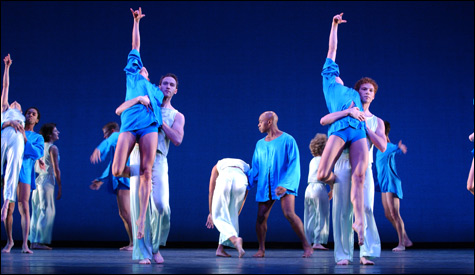
V: A fine opportunity to revisit this piece for twin ensembles in blue and white. |
Modern-dance repertory is mostly a historical category these days, if not an oxymoron, so when the Celebrity Series announced that the Mark Morris Dance Group would do three older pieces for its annual Boston appearance, we got a chance to revisit works we haven't seen in a while. Morris's fine company of 19 dancers brought along a feast of Schubert, Bartók, and Schumann performed by its own ensemble of musicians plus mezzo-soprano Katherine Growdon and five singers from Emmanuel Music.Old pieces is a relative term, and the most substantial work on last weekend's program at the Cutler Majestic dates from 2001. Its title, V, may refer to its music, Robert Schumann's Piano Quintet. (Violinists Jennifer Curtis and Georgy Valtchev, violist Jessica Troy, cellist Hrant Parsamian, and pianist Steven Beck made up the MMDG Music Ensemble.) The other dances were Bedtime (1992) and All Fours (2003).
For V, Morris devised twin ensembles of seven dancers. The first group, in blue, start out in a V formation; their moves are echoed later by the group in white. Both the floor pattern and the color-coded costumes become structuring implements for the dance, along with the music, of course. As the dancers stream in and out, one cadre imitates the other, or they combine forces in pairs and smaller units. All the men line up on a diagonal and do a fussy chain pattern. Later all the women to the same thing as the music repeats.
The movement has a halting quality — people move, then freeze in sculpted poses as other people take over the momentum. Just when they look as if they were about to loosen up and swing their arms, it turns out they're simply inventing new picturesque poses. When Schumann lurches forward in a solemn march, the dancers pitch over and crawl on their fingers and toes, one step per note. In the concluding fugue, the two V's make competing claims to the territory and finally mesh.
V was the final work on the program. By that time, all the movement had begun to look alike — except for the crab crawls. All three pieces used contrasting groups of dancers. Unlike V, the other two seemed to have stories ingrained in them that had seeped in through the music.
The three familiar Schubert lieder for Bedtime do share themes of nurturing, trust, and apprehension. In the cradle song "Wiegenlied," Elisa Clark hovers protectively over three peersons curled up on the floor. In "Ständchen," Clark, Joe Bowie, David Leventhal, and Bradon McDonald slip among eight "sleepers," perhaps trying to rouse them.
Then these four seem to enact the tragic scene in "Erlkönig." A father rides home with his son, but the son imagines a sinister figure who's calling him from another shore. At the end of the journey, the child is dead. The quartet's posturings — pointing, recoiling, running — seemed melodramatic and opaque, but oddly touching.
All Fours, to Béla Bartók's String Quartet No. 4, was filled with dramatic implications that surfaced and sank back into the dancing: prayerful gestures, people clinging to other people, people being caught in mid air by other people and pinned in strange positions. Two groups circled around doing a kind of tribal war dance. Then they spread out in two lines and pumped their arms in a cheerless imitation of the monkey.